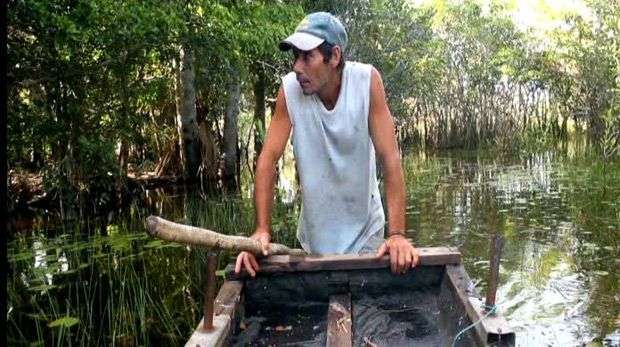Since The Mégano (1955) burst onto the scene of Cuban films, the contradiction between the incredible natural landscapes and the difficult life of the inhabitants of the Zapata Swamp, is presented as a discovery that seems to have no end. Cenagueros (swamp people), not farmers, the locals of the largest wetland in the Caribbean are once again the protagonists in the documentary short film Cocodrilo’s Men. Under the leadership of director Livan A. Magdaleno Cruzata, the swamp and its inhabitants put their demons in this material, which is applying to participate in the next edition of the Havana Festival of New Latin American Cinema and was the winner of the scholarship of creation, The kingdom of this world, of the Hermanos Saiz Association.
On Cocodrilo’s Men Livan spoke with OnCuba
How was the research for the documentary?
This documentary was based on the original idea of Francisco Delgado. I always had been motivated to shoot in a remote area of the country where I could find interesting stories, as in some festivals we find inner-city stories and themes that are sometimes repeated, and the public may be a little tired of them.
The idea has its precedent in an anthropological investigation of Adrian Alvarez Chavez, who served as the primary source to find out what was really going on in the town of Cocodrilo and thereafter we developed a first stage to know how the people were, know the environment, flora, and fauna.
In the first weekend we went to share with the locals, know them to see what their wants were and see what was really happening and compare that with the research made by the specialist.
This made me decide that I wanted to do in the film. I decided to use interviews or interactive mode, because through this kind of journalism I would have a more accurate for multiple people to tell their own stories, as there are issues that cannot be told through images. After this we decided to follow a Brechtian dramaturgy through chapters recounting several facts that will mat segmented by thematic areas.
In my opinion, the relationship between filmmakers and actors in this film is reversed, and interviewed very well appropriated it; how do you feel about it?
Unquestionably it does, but it was the idea that these characters have a voice, ie silence that has accompanied them for years had to be broken in some way with our work. It is a community that is supposed to develop through the Manati Turquino Plan, but it has not obtained it, so yeah, that was one of the things we try to focus on: characters that could bring their own vicissitudes.
We share much time with them even their resources and ours, because we did not want to get without knowing what the basis of their problems and film directly, lived even in their homes, so this certainly contributed to them to be comfortable and feel the documentary.
They are not peasants in the strict sense of the word, because they live off the land, not the cause, either because it is in their traditions or because the local soil does not meet these conditions, they are cenagueros, and this is not should lose sight of when creating a plan for its development as a community, and it is often not taken into account. We try to display it in the documentary.
The gender issue is present in Cocodrilo’s Men…. Does it arise when they get there, or was one of the objectives of the project?
The gender issue was there when we developed the film project was one of the main objectives. Our intentions were to find at least one woman who gave her testimony. Because we know machismo is seen in the country’s rural areas as a tradition. The idea was to take this topic so that appear as edge in all the characters and that the woman herself could tell her problem in the story. There appears double function: work outside the home and housework.
The soundtrack of the documentary uses original resources how was its creation?
The soundtrack is worked in a more direct way, because from the time of filming I knew what I wanted. I appropriated some effects of the place, very clean sounds where we find nothing in town. I wanted to break the myth rather use the Guajira , to show the Cuban countryside . I wanted to use different sounds to build a language of feelings that could show part of what is happening as a chain of events.
I was looking for an interpreter time a berimbau (Jew’s harp) (Brazilian instrument, used to practice capoeira) as their sound was a mixture of strong emotions tied to the survival instincts that appear in the documentary. It is a mixture of ambient sound and musical instruments basically.
Why did you pay homage to The Mégano?
It was not intended to take the Mégano as a pretext and make a questioning work. We took The Mégano because it was the first documentary to be made about this place, but also aesthetically pay homage to documentary film of the decade of the 60s and 70s, such as the work of Sara Gomez, Bernabe Hernandez.
The Mégano is a referential element but is told in a different way, from the twenty-first century, but if it comes to the same end: after so many years this place remains the same.
What does Cocodrilo’s Men leave to Livan?
It really is the documentary that took me most time until now. It took almost a year. Regarding the structure contains a better structure. In every job I’ve done I try to tell stories in different ways. From the very beginning of the work we identify with the problems of its characters and hope that closeness also gets to the receivers.
For: Mayté Madruga Hernández










